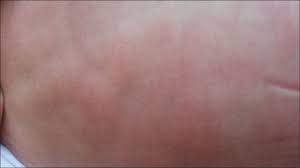FAT NECROSIS

Definition: Fat necrosis is a form of necrosis (premature death of cells) characterized by the action upon fat by digestive enzymes. [1]
Fat necrosis is a benign (non-cancerous) condition in which damaged and disintegrating fatty tissues form round, firm lumps in the breast tissue. [1] The lumps are usually painless and the skin around the lump may look red, bruised or dimpled. [1]
Pathophysiology
In fat necrosis the enzyme lipase releases fatty acids from the storage form of fat (triglycerides.) The fatty acids released then complex with calcium to form soaps that are white, chalky deposits seen on radiological studies. The exact pathogenesis of subcutaneous fat necrosis is somewhat unknown, but it is postulated that cold or stress-induced injury to immature fat results in the development of solidification and necrosis. [3]
Fat necrosis is usually associated with trauma, and commonly occurs in the pancreas or breast. [2] For example, this condition sometimes occurs following breast surgery (including breast-reduction surgery) or radiation to the breast. [6]
Breast Fat Necrosis
Fat necrosis is a firm, usually round lump that forms in an area of fatty breast tissue that has been damaged. As noted this may occur due to previous surgery or injury to the breast (although many women may not remember any specific injury). The lump is usually painless, and the skin around it may look red, bruised or dimpled. Fat necrosis following breast reduction is a relative infrequent problem. [3]
Findings from scans (mammogram, ultrasound) can be suspicious for fat necrosis and radiologist can determine fairly accurately if there is indeed fat necrosis in the breast. Certain patterns show on x-ray reveals fat necrosis. Sometimes an MRI might also be done to further evaluate the area. These findings can be more or less suspicious but definite diagnosis of fat necrosis would be through biopsy of the tissue. [3]
Treatment
These lumps are not malignant and there is no reason to believe that they increase a woman’s risk of cancer.
Surgical excision is the definite treatment, but it is not mandatory. If you are symptomatic (the mass is painful) resection of the area is possible. Full resection of a mass may leave some shape deformity of the area, depending on the size. A partial surgical resection can be done, but usually there will still be a hard or painful area that may continue to be uncomfortable. [3]
Other treatment techniques (such as an attempt to dissolve and break up the fat with ultrasonic liposuction) will probably not work. [4]
Treatment for breast fat necrosis symptoms (including pain or hard lumps) may include:
- Apply warm compresses for 20-30 minutes, every 4 hours.
- Nonsteroidal anti-inflammatory medications (such as Advil) for pain
- Narcotic pain medication (for much more severe pain) [5]
References:
1. Necrosis. http://library.med.utah.edu/WebPath/CINJHTML/CINJ026.html
2. Kumar, Vinay; Abbas, Abul K.; Fausto, Nelson; & Mitchell, Richard N. (2007). Robbins Basic Pathology (8th ed.). Saunders Elsevier. pp. 10-11
3. Breast Cancer Forum. http://www.medhelp.org/posts/Breast-Cancer/Fat-Necrosis/show/260193
4. Breast reduction fat necrosis. Howard Rosenberg, MD. http://www.medhelp.org/posts/Cosmetic-Surgery/breast-reduction-fat-necrosis/show/279955


